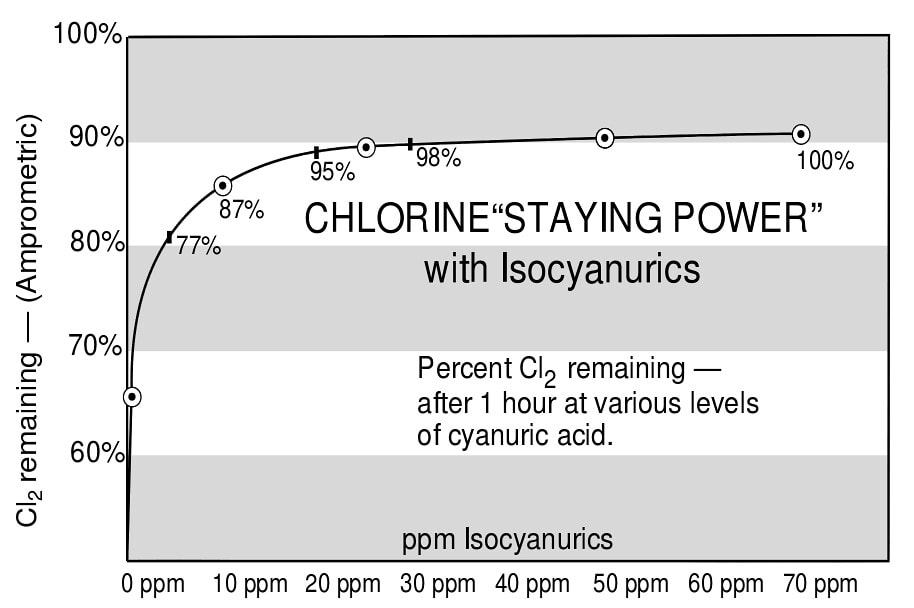High cyanuric acid is a problem in most chlorine pools. Commercial facilities with large tablet chlorinators sometimes drain the pool multiple times in a summer. Health department code in Tarrant County stipulates that any commercial facility over 100 ppm needs to be shut down due to kill time. Kill time in a swimming pool refers to how long does it take to kill bacteria after it enters the pool In residential pools there is not a specific cut off point, but most pool professionals will tell you that over 100 ppm it needs to be diluted some. The theory is as cyanuric acid level increases, kill time also increases. Usually around 200-300 ppm you can run into chlorine block. Meaning the cyanuric acid or stabilizer level is high enough to render the chlorine completely ineffective. At this point your pool will likely turn green, you shock the heck out of it, test the chlorine and its high, ph is in check and you still have a green pool. I have seen countless homeowners struggle with green pools and high cyanuric acid and not understand the correlation and change of events that caused the situation. Any pool that is using chlorine tablets or trichlor as it is commonly known will suffer from high cyanuric acid at some point. At Texas Trophy pools we typically recommend changing out or draining the pool every 3 years or so. Some circumstances can change this recommendation, such as high bath load leading to high chlorine usage. Dogs that swim in the pool can create loads of problems, one dog swimming in the pool is equal to at least 10 people in the pool. If they get in and out frequently, they will pull lots of water out of the pool which can lead to large amounts of water loss. If you have a trichlor pool, no dogs or environment issues and you don’t have high cyanuric acid levels after 3 years then something is going on. Either you are backwashing 6 inches of water out of the pool weekly or you have a leak. In Texas with over 100-degree days you shouldn’t be losing more than an 1/8 of a inch a day. A professional who watches the chemicals closely can tell in a heart beat if you are losing water based off the water tests over a few weeks to a few months.
How can you control high cyanuric acid? Additional backwashing or extended backwashing can help and extend time between needing to drain the pool. We always switch from tabs to shock only during the winter months. This is accomplished primarily because we are making weekly trips and the water temps are suitable to only using granulated chlorine. The two main types are granulated chlorine are calcium hypo chlorite or cal hypo, also sodium dichlor or dichlor is also used. Cal hypo is calcium based and will slowly increase the calcium level. Usually we see calcium levels rise and cyanuric acid levels rise using this method over the 3 year window. Part of professionally balancing a swimming pool is using the LSI index. As cyanuric acid and calcium levels rise adjustments should be made to other parts of the water chemistry to account of the LSI index. We primarily use cal hypo as do most pool professionals in the region mainly because it is the strongest and costs the least. Sodium dichlor is sodium based as well has sodium hypochlorite, both will increase the salt level in your swimming pool. I’ve personally seen a commercial pool with a sodium hypochlorite feeder push the sodium level so high you could taste the salt in the pool. This happens in a short window due to bathe load, a high bathe load will cause a chemical feeder to use a lot of chlorine to kill all the bacteria in the pool. For reference you can taste the salt in the pool at around 3000 ppm.
Another way to control cyanuric acid is to turn your pool into a salt water pool. A salt system typically set between 3000-3500 ppm, some systems require over 4000 ppm, will generate chlorine gas. Salt water chlorination is a process that uses dissolved as a store for the chlorination system. The chlorine generator uses electrolysis to produce chlorine gas or its dissolved forms -hypochlorous acid / sodium hypochlorite – which is the sanitizing agent already commonly used in swimming pools. Hydrogen is produced as byproduct too. Therefore, a saltwater pool is not actually chlorine free; it simply utilizes added salt and a chlorine generator instead of direct addition of chlorine. Under this operation cyanuric acid is manually added. Due to water loss of backwashing or splash out it is typically added a few times a year. As you can see from the cyanuric acid efficiency chart or stabilizer efficiency chart at around 30-40 ppm its at 98% efficient. Most salt system manufacturers recommend keeping it at 70 ppm to get 100 efficiency.
This relates to the efficiency of chlorine in swimming pools. Cyanuric acid has many benefits such as protecting chlorine dissipation due to heat and uv rays. 50years ago cyanuric acid didn’t exist and everyone need to add chlorine to their swimming pool almost constantly. Most commercial swimming pools has gas chlorine feeders that constantly put chlorine in the pool. Today we are lucky to have cyanuric acid without it weekly pool service would be possible with out expensive and dangerous gas chlorine systems. Salt water generators only produce .5 to 1 lbs of chlorine every 24 hours of run time which would not be enough free chlorine to keep your pool clean and clear without cyanuric acid.
#pools
@TxTrophypools
Thanks
TexasTrophyPools.com
Arlington Mansfield Pool Service, Repairs, and Renovations

